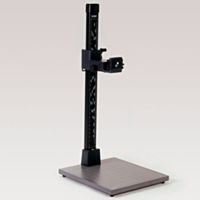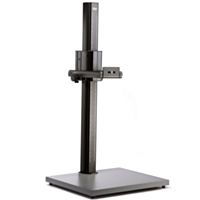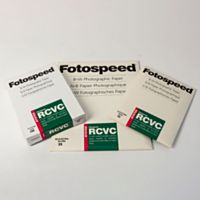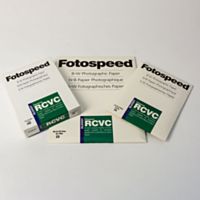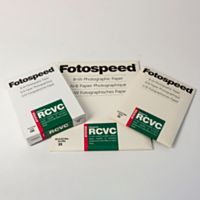Fotospeed LE30 Liquid Emulsion Fixed Grade 250ml - Fotospeed
Fotospeed LE30 LiquidEmulsion Fixed Grade 250ml
Fotospeed LE30 Liquid Emulsion is a Black & White photographic emulsion grade 2 supplied in a form that
allows the user to apply it to any surface if the following instructions are adhered to. At all times it should be
remembered that you are dealing with a light sensitive product and therefore the precautions for a normal B&W paper should be followed.
PREPARATION FOR USE
Heat container in a water bath to a maximum temperature of 50°C. Leave the lid on to prevent water entering the tub or bottle. The emulsion should turn to a creamy liquid in approximately 5 minutes.
Pour emulsion required into a beaker and add water at approx 40°C to the emulsion at the mixture of 1 part emulsion to 1 part water. Gently agitate the beaker to cause the water and emulsion to mix. Continue heating the beaker until a uniform mixture is obtained. At this point the emulsion is ready for application. For richer images the emulsion can be used neat.
APPLYING THE EMULSION
You may work under RED safelight but keep the safelight at least 3 feet away from where you are coating.
Ensure that the surface to which the emulsion is being applied is clean and free from grease.
For surfaces such as glass, ceramics, stone etc. a subbing layer is recommended to assist the emulsion to adhere to the surface. This is achieved by using any crystal clear varnish. Paint the varnish onto the surface and allow to fully dry, this now forms a key to which the emulsion can attached itself.
Pour the emulsion onto the surface to be coated and either brush it across the surface or if the surface is perfectly flat a rubber or plastic roller can be used. Remember that ideally the temperature of the emulsion should be maintained otherwise as the emulsion cools on contact with a cold surface then you
will end up with a thicker emulsion layer.
Once coated either place the coated surface in a refrigerator (ensure that the fridge light has been disconnected before opening the fridge!) for about 5 minutes to allow the emulsion to harden. Alternatively a hairdryer set to cool can also successfully dry the emulsion.
EXPOSURE
Place the coated surface under the enlarger and cover it with either light proof black paper or light proof black plastic. Place a piece of white paper as a focusing sheet directly on the light proof material and turn on the enlarger and make the necessary focusing alterations and stop down. Turn off the enlarger.
Remove the focusing sheet and light proof material and make your exposure. Alternatively for enlargers with a safety glass that swings in under the lens the requirement for the black light proof material and focusing sheet is not necessary.
PROCESSING
The same processing sequence as for normal B&W processing is used, ie. Fotospeed PD5 Print Developer and Fotospeed FX20 Rapid Fixer. We also advise the use of a plain water rinse and not stop bath since the acid in stop bath might attack some materials.
Do not exceed 20°C at any stage of processing.
Preferably process at below 20°C and compensate the
exposure.
Treat the surface with care and immerse it in a print
developer. If this is not possible due to shape or size then pour developer repeatedly over the exposed surface. Try not to develop for more than 2.5 minutes. Fix for a good 4 minutes in the same manner as for development. Use hardener in the fixer where possible.
Washing should be done as for a normal print remembering that non-porous surfaces will wash in 5 minutes whereas porous surfaces will need 20 minutes - but gently.
Drying can be done either by allowing the object to dry
naturally or with the use of a hair dryer set to cool.
Only open and work in a darkroom. Red safelights for black and white photographic paper can be used. Never open in normal light. Preferably keep tub in complete darkness when not in use.
Fotospeed LE30 Liquid Emulsion is a Black & White photographic emulsion grade 2 supplied in a form that
allows the user to apply it to any surface if the following instructions are adhered to. At all times it should be
remembered that you are dealing with a light sensitive product and therefore the precautions for a normal B&W paper should be followed.
PREPARATION FOR USE
Heat container in a water bath to a maximum temperature of 50°C. Leave the lid on to prevent water entering the tub or bottle. The emulsion should turn to a creamy liquid in approximately 5 minutes.
Pour emulsion required into a beaker and add water at approx 40°C to the emulsion at the mixture of 1 part emulsion to 1 part water. Gently agitate the beaker to cause the water and emulsion to mix. Continue heating the beaker until a uniform mixture is obtained. At this point the emulsion is ready for application. For richer images the emulsion can be used neat.
APPLYING THE EMULSION
You may work under RED safelight but keep the safelight at least 3 feet away from where you are coating.
Ensure that the surface to which the emulsion is being applied is clean and free from grease.
For surfaces such as glass, ceramics, stone etc. a subbing layer is recommended to assist the emulsion to adhere to the surface. This is achieved by using any crystal clear varnish. Paint the varnish onto the surface and allow to fully dry, this now forms a key to which the emulsion can attached itself.
Pour the emulsion onto the surface to be coated and either brush it across the surface or if the surface is perfectly flat a rubber or plastic roller can be used. Remember that ideally the temperature of the emulsion should be maintained otherwise as the emulsion cools on contact with a cold surface then you
will end up with a thicker emulsion layer.
Once coated either place the coated surface in a refrigerator (ensure that the fridge light has been disconnected before opening the fridge!) for about 5 minutes to allow the emulsion to harden. Alternatively a hairdryer set to cool can also successfully dry the emulsion.
EXPOSURE
Place the coated surface under the enlarger and cover it with either light proof black paper or light proof black plastic. Place a piece of white paper as a focusing sheet directly on the light proof material and turn on the enlarger and make the necessary focusing alterations and stop down. Turn off the enlarger.
Remove the focusing sheet and light proof material and make your exposure. Alternatively for enlargers with a safety glass that swings in under the lens the requirement for the black light proof material and focusing sheet is not necessary.
PROCESSING
The same processing sequence as for normal B&W processing is used, ie. Fotospeed PD5 Print Developer and Fotospeed FX20 Rapid Fixer. We also advise the use of a plain water rinse and not stop bath since the acid in stop bath might attack some materials.
Do not exceed 20°C at any stage of processing.
Preferably process at below 20°C and compensate the
exposure.
Treat the surface with care and immerse it in a print
developer. If this is not possible due to shape or size then pour developer repeatedly over the exposed surface. Try not to develop for more than 2.5 minutes. Fix for a good 4 minutes in the same manner as for development. Use hardener in the fixer where possible.
Washing should be done as for a normal print remembering that non-porous surfaces will wash in 5 minutes whereas porous surfaces will need 20 minutes - but gently.
Drying can be done either by allowing the object to dry
naturally or with the use of a hair dryer set to cool.
Only open and work in a darkroom. Red safelights for black and white photographic paper can be used. Never open in normal light. Preferably keep tub in complete darkness when not in use.
- Black & White photographic emulsion grade 2 supplied in a form that when heated in a water bath, will melt allowing it to be applied to varying surfaces.
- Light sensitive product, develop and fix as for any Black and White paper.
- Full instructions for coating and exposure come with the product.
- Black & White photographic emulsion grade 2 supplied in a form that when heated in a water bath, will melt allowing it to be applied to varying surfaces.



